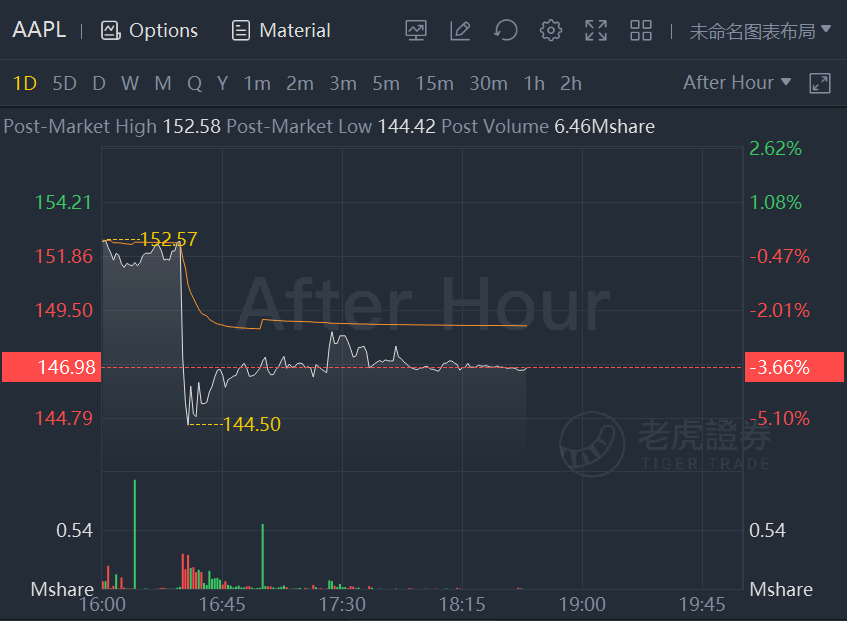Apple revenue fell short of Wall Street expectations in its fiscal fourth quarter on Thursday, which Apple CEO Tim Cook attributed to larger-than-expected supply constraints on iPhones, iPads, and Macs.
Apple fell 3.7% in extended trading.
"We had a very strong performance despite larger than expected supply constraints, which we estimate to be around $6 billion," Cook said. "The supply constraints were driven by the industry wide chip shortages that have been talked about a lot, and COVID-related manufacturing disruptions in Southeast Asia."Cook said that the impact will be even worse during the current holiday sales quarter.
However, Apple's overall revenue was still up 29% and each of its product categories grew on an annual basis.
Here's how Apple did versus Refinitiv consensus estimates:
- EPS: $1.24 vs. $1.24 estimated
- Revenue: $83.36 billion vs. $84.85 billion estimated, up 29% year-over-year
- iPhone revenue: $38.87 billion vs. $41.51 billion estimated, up 47% year-over-year
- Services revenue: $18.28 billion vs. $17.64 billion estimated, up 25.6% year-over-year
- Other Products revenue: $8.79 billion vs. $9.33 billion estimated, up 11.5% year-over-year
- Mac revenue: $9.18 billion vs. $9.23 billion estimated, up 1.6% year-over-year
- iPad revenue: $8.25 billion vs. $7.23 billion estimated, up 21.4% year-over-year
- Gross margin: 42.2% vs. 42.0% estimated
iPhone sales were up 47% year-over-year, but still came in under Wall Street estimates.
Apple's results were mixed in a fiscal fourth quarter seen as a lull before the high-sales holiday end of year.
Apple said revenues and profits for the fiscal fourth quarter were $83.4 billion and $1.24 per share, compared with analyst estimates of $84.8 billion and $1.24 per share, according to IBES data from Refinitiv.
The results were a rocky end to a fiscal year of above-expectations sales led by its iPhone 12 models and strong sales of Mac computers and iPads for working and learning from home during the COVID-19 pandemic.
Apple told investors in July that chip constraints would start to hit its iPhone and iPad lineups for the first time in the fourth quarter.
Apple posted its results shortly after retailer Amazon.com forecast holiday-quarter sales well below Wall Street expectations, citing labor supply shortages and global supply chain issues in part.
Apple has "managed to navigate the problems fairly well, but hasn’t escaped unscathed, and an extended duration of these problems will spell trouble, especially because the market is unforgiving when it comes to Apple’s performance," said Sophie Lund-Yates, equity analyst at Hargreaves Lansdown.
MISSES
Apple missed expectations in two key categories.
Apple said fourth-quarter iPhone sales were $38.9 billion, short of estimates of $41.5 billion, according to Refinitiv data.
Cook said that chips made with older technology remain the key supply constraint. He said that Apple remains unsure whether the shortages will ease after the holiday shopping season.
"It's very difficult to call," Cook said.
The company's accessories segment, which contains fast-growing categories like its AirPods wireless headphones, came in at $8.8 billion, half a billion dollars lower than analyst expectations of $9.3 billion, according to Refinitiv data.
Other segments fared better. Sales for iPads and Macs were $8.3 billion and $9.2 billion, compared with analyst estimates of $7.2 billion and $9.2 billion, according to Refinitiv data.
The company's services segment - which contains its App Store business - had sales of $18.3 billion in revenue, up 26%, compared with analyst expectations of $17.6 billion. Cook said that Apple now has 745 million paid subscribers to its platform, up from the 700 million it disclosed a quarter ago.
"Services were strong, and it shows the beauty and durability of software and services, as there are better margins and no supply issues, since software doesn't arrive on a container ship," said Hal Eddins, chief economist at Apple shareholder Capital Investment Companies.
Another bright spot in the company's results were its sales in China, which were up 83% to $14.6 billion.
The company said it returned $24 billion to shareholders during the quarter.


